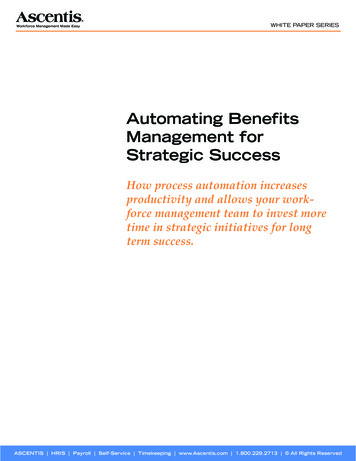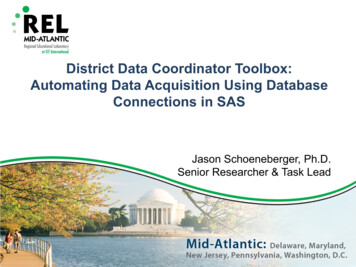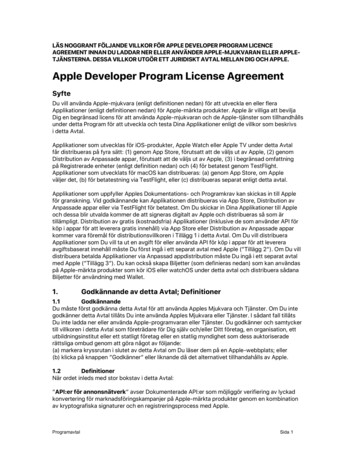
Transcription
Workforce Management Made EasyWHITE PAPER SERIESAutomating BenefitsManagement forStrategic SuccessHow process automation increasesproductivity and allows your workforce management team to invest moretime in strategic initiatives for longterm success.ASCENTIS HRIS Payroll Self-Service Timekeeping www.Ascentis.com 1.800.229.2713 All Rights Reserved
ASCENTIS WHITE PAPER: Automating HR and Benefits Management for Strategic Success2Table of ContentsMaximizing the potential of the HR department. 3What to look for in an HRIS. 4Benefits for the entire organization. 5Essential features. 7The future of HRIS. 8Conclusion. 9ASCENTIS HRIS Payroll Self-Service Timekeeping www.Ascentis.com 1.800.229.2713 All Rights Reserved
ASCENTIS WHITE PAPER: Automating HR and Benefits Management for Strategic Success3Maximizing the potential of the HR departmentThe majority of anHR department’stime and resourcesis consistentlytaken up with dayto-day tacticalissues -up tofive hours ofevery eighthour day somestudies suggest.HR departments in mid-tier organizations are models of versatility.Their responsibilities include everything from answering employeequestions about health benefits and vacation time and sorting outthe process of employee reviews, to high level long term planningand organization of training, employee retention plans, managementdevelopment and other important issues that fundamentally affectthe productivity and success of the organization.Most organizations of this size would agree that they would greatlybenefit from their HR professionals having the opportunity to focusmore of their energies on strategic issues, as is the case in largerorganizations. It is no secret that the top-performing companies inthe S&P 500 are the ones that have the strongest focus on employeedevelopment.However, in reality, the majority of their HR department’s time andresources is consistently taken up with day-to-day tactical issues—up to five hours of every eight-hour day, some studies suggest.For larger companies, the technology to automate HR and benefitsissues has been available for some time, and is widely used. Howeverthe resources and infrastructure required to install and maintainone of these large and complex systems has made the cost of entryprohibitive, both financially and technologically, for companies in themid tier. As a result, only about 15% of mid-tier companies have yetadopted a Human Resource Information System (HRIS) solution.Today, software solutions are emerging that can provide a practicalanswer to organizations of this size. The problem then becomes howto choose the one that is the best fit for their requirements and that isaffordable, flexible and agile enough to cope with constant change,whether it comes from within the organization or from legislationsuch as HIPAA and the E-sign Act.ASCENTIS HRIS Payroll Self-Service Timekeeping www.Ascentis.com 1.800.229.2713 All Rights Reserved
ASCENTIS WHITE PAPER: Automating HR and Benefits Management for Strategic Success4What to look for in an HRISA satisfactoryHRIS must have itsHR and benefitsfunctions highlyintegrated, mustbe agile and robust. and must beeasyto use,configure andmaintain.First and foremost, a good HRIS needs to be based on a solid,modern technology foundation.A quick survey of the marketplace will show that there is a widerange of solutions available today. Further study, however, willreveal that most of them are designed for very large organizations,costly to set up and maintain, based on heavy-duty legacytechnology and requiring the services of an army of consultants tokeep them operational. Most of the systems designed for smallerorganizations concentrate heavily on either HR functions such asattendance and compensation, or on benefits management, but lackthe ability to combine the two issues.To be a practical investment choice for a mid-tier organization, asatisfactory HRIS solution must have its HR and benefits functionshighly integrated. It must be both agile and robust in order that it caneasily be kept abreast of constant change, and it must be built on atried and true foundation that is both easy to use and maintain, suchas a modern database like SQL Server.Ease of use is a vitally important feature for an HRIS. The learningcurve on any new software is often a challenge for people whoseprimary function is non-technical, such as the average HR consultant.It is important that if the investment is made in a product, it isaccepted to the extent that it becomes part of the fabric of thedepartment. There are three things to look for that will make anHRIS easier to use and more accepted by staff:Wizards: Wizard-based technology makes it easy for staff toenter or import information and make changes and updates, byfollowing through a set of simple instructional, fill-in the blanksforms on the screen, rather than their having to learn to programor call in the consultants.Strong HR facilities combined with flexible benefit capabilities:The system should be able to handle compensation, attendanceand recruitment, and legal requirements such as FMLA andOSHA, while integrating them with benefits issues such asCOBRA.ASCENTIS HRIS Payroll Self-Service Timekeeping www.Ascentis.com 1.800.229.2713 All Rights Reserved
ASCENTIS WHITE PAPER: Automating HR and Benefits Management for Strategic SuccessUnless thechosen solutionoffers benefitsto everyone inthe organization,it will notsucceed.5Role-based operation: A good HRIS solution should be ableto cater to the needs of a wide range of people and functionswithin the organization, and should appear seamlessly tailoredto their requirements. Role based administration is becomingincreasingly important in the HRIS marketplace. With this feature,HR administrators can define what an individual can see in thesystem, allowing managers access to the information they needabout their particular team, while locking them out of informationthat is not pertinent to them. Role based administration canextend further into proactive alerting—a particular manager ormanagement level can be automatically alerted by the systemthat it is time to conduct a review, for instance, with those alertsbeing based on the specific mangers role and needs within theorganization.Benefits for the entire organizationThere are three constituencies whose needs must be addressed inthe selection of a new HRIS solution: HR and IT managers, the HRdepartment itself, and the “customers,” i.e., the executives, managersand other employees of the company.HR and IT managers must be satisfied that they have chosen thebest tool for the job—one that is going to offer a good return on theirinvestment of both financial and time resources; the HR departmentmust find that the solution allows them to become strategic thinkersrather than data processors, and employees must find that they arereceiving a more efficient service and are able to make better andeasier choices.Unless the chosen solution offers benefits to everyone in theorganization, it will not succeed.For HR and IT managers, the questions are largely fiscal andorganizational: Will one solution span both benefits and HR requirements,or will it be necessary to integrate products from differentvendors to fulfill their requirements?Is the system affordable and within the budget of a midsizedorganization?ASCENTIS HRIS Payroll Self-Service Timekeeping www.Ascentis.com 1.800.229.2713 All Rights Reserved
ASCENTIS WHITE PAPER: Automating HR and Benefits Management for Strategic SuccessFor HR and ITmanagers, thequestions arelargelyfiscal andorganizational.For HR personnel,the issues aremore focused onoperations.Employees are morelikely to be focusedon theend results. 6Is the system intuitive enough for people with a wide range ofdifferent skill levels?Is the solution provider a solid and reputable company whowill be there in future years to provide upgrades and supportas technology changes?Will the installation and startup take so long and be soexpensive that it won’t be possible to configure all ofthe features?What is the total cost of ownership over time? Will consultantsbe returning repeatedly to reprogram the system for new ordifferent benefit plans, to implement different features,or to train employees?For HR personnel, the issues are more focused on operationalmatters: Will it reduce their workload, for instance, by allowingthem to offload some of the burden of managing employeedata to departmental managers?Will it automate mundane tasks such as notification of events(management reviews, etc.,) in order to allow them to workon more important issues for the organization, suchas employee retention policies, workforce optimizationprograms, or training and education aimed at improvingproductivity?Will the system be user-friendly enough so average HRadministrators and employees can and will use it?Will this increase employee satisfaction and productivity, andenable better choices for employees?Employees are more likely to be focused on the end results: Will it enable them to access HR information, such as howmany vacation days they have available or when theirnext salary review is due, quickly and easily?Will it ensure that personal information, such as dependents,addresses and emergency contacts stay up to date?Will it increase the range of benefit plan choices available tothem and make it easier for them to choose the correct benefitplan?ASCENTIS HRIS Payroll Self-Service Timekeeping www.Ascentis.com 1.800.229.2713 All Rights Reserved
ASCENTIS WHITE PAPER: Automating HR and Benefits Management for Strategic SuccessThere arefive Will it provide easy access for them to information such aslists of approved doctors and explanations of benefitcoverage?Will it reduce the number of errors in medical claims?an HRIS needs toEmployees are also seeking easier access to information about theirown organization, other employees and how to reach them, as wellas better communication from management about critical corporateissues that could directly affect them.address. TheseEssential featureskey features thatfeatures will makeit easy to manage arange of HR issues,employee benefitplans, and benefitsenrollment matters.7There are five key features that an HRIS needs to address. Thesefeatures will make it easy to manage a range of HR issues, employeebenefit plans, and benefits enrollment matters: Integration of all HR management functions. Informationabout compensation, attendance, FMLA and other HRfunctions should be readily accessible to appropriateemployees.Ease of use. The program should be easily configurable byHR and benefits managers. Importing data and configurationof HR policies, benefit plans, leave types, etc., should all beeasily done without requiring formula-building or theprogramming services of expensive consultants. Inaddition, ease of use should extend to the system’s reportingcapabilities — commonly-used reports should bepreformatted so the user doesn’t have to learn a complicatedreport writer.Support for all plan types. This includes offering theflexibility to include non-traditional voluntary benefits such asprepaid legal, AFLAC, dental coverage, parking or evenmembership of a local health club.Distribution of workload across the organization. Managersshould have access to the information and tools they need toeffectively manage their own staffs.A powerful and flexible benefits engine for full benefitsmanagement. This must be able to calculate eligibility,volumes and costs. Reporting features should includefacilities to alert managers of any issues in reconciliation ordifferences in bills received from plan providers.ASCENTIS HRIS Payroll Self-Service Timekeeping www.Ascentis.com 1.800.229.2713 All Rights Reserved
ASCENTIS WHITE PAPER: Automating HR and Benefits Management for Strategic Success8The Future of HRISLeading vendors ofHRIS solutions areensuring that theirsoftware is fullyInternet enabledandable totransfer dataelectronicallyto carriers.This is a keyconcept in makingcomplete endto-end benefitsenrollment a viableproposition.In looking at HRIS solutions, it is important to look at the longerterm prospects for the technology. The HR industry is in a state offlux, and any product that a company installs today must be basedon a platform that can readily and rapidly adapt to change, and mustoffer concrete plans for coping with the future.In an ideal world, widespread, electronically enabled end-to-end HRmanagement and benefits enrollment would be the norm. Employeesthemselves would be able to perform many operations such asonline benefits enrollment and selection, the updating of personalinformation, and other tasks such as viewing compensation andbenefits information that are currently performed for them by anHR professional. Relevant data would be routed based on businessprocesses, allowing role-based task assignment and monitoring,allowing team leaders to manage their own staff without the constantneed for the services of the HR department.Two things are helping turn this concept of complete end-to-endbenefits enrollment into a reality. First of all, the advent of the HIPAAAdministrative Simplification laws. By making the acceptance ofstandard electronic data formats mandatory for all carriers andbenefit vendors across the country, HIPAA makes it possible forsoftware vendors to create a common interface using these new datastandards, allowing enrollment information to be transferred to theinsurance carriers and TPA’s electronically, eliminating the errorprone manual system that exists today.Secondly, leading vendors of HRIS solutions are ensuring thattheir software is fully Internet enabled and able to transfer dataelectronically to benefits carriers. This is a key concept in makingcomplete end-to-end benefits enrollment a viable proposition. Itenables the user through employee self-service to access and usetheir HR and benefits information from just about anywhere. Itmakes electronic benefits enrollment possible and will also allowonline premium remittance, whether via the Internet, a VirtualPrivate Network, or through a standard modem connection.ASCENTIS HRIS Payroll Self-Service Timekeeping www.Ascentis.com 1.800.229.2713 All Rights Reserved
ASCENTIS WHITE PAPER: Automating HR and Benefits Management for Strategic Success9ConclusionAutomationmust be broughtabout in such away that the HRdepartment cantruly become moreproductive,rather than simplyexchanging one setof tactical tasksfor another, and itmust be done costeffectively.In today’s rapidly changing business environment, the need for theHR department to be freed to be a more of a strategic force in theorganization has become apparent. In order for this to happen, it isessential that mundane, day-to-day tasks be automated.This automation must be brought about in such a way that the HRdepartment can truly become more productive, rather than simplyexchanging one set of tactical tasks for another, and it must bedone cost-effectively. The solution chosen has to be easily usableand configurable by regular HR staff. In a constantly and rapidlychanging environment such as HR, it isn’t practical for every minorchange in policy to require precious resource be spent on employingoutside consultants to reconfigure systems.The chosen solution also has to offer significant benefits to end useremployees, whether they will use it in a “self-service” fashion, or stillreceive their answers through the HR department. These benefitsinclude immediately apparent advantages such as faster and moreaccurate responses and less reporting errors, but also more importantand long-term features such as a broader range of benefit choices.Lastly, the chosen solution has to offer a solid return on investment.Not only through greater employee satisfaction and the freeing of theHR department for more important strategic functions, but in actualterms of reduced benefit costs through greater efficiency in planadministration, less errors and faster pick-up of problems and issues.Workforce Management Made mASCENTIS HRIS Payroll Self-Service Timekeeping www.Ascentis.com 1.800.229.2713 All Rights Reserved
adopted a Human Resource Information System (HRIS) solution. Today, software solutions are emerging that can provide a practical answer to organizations of this size.











